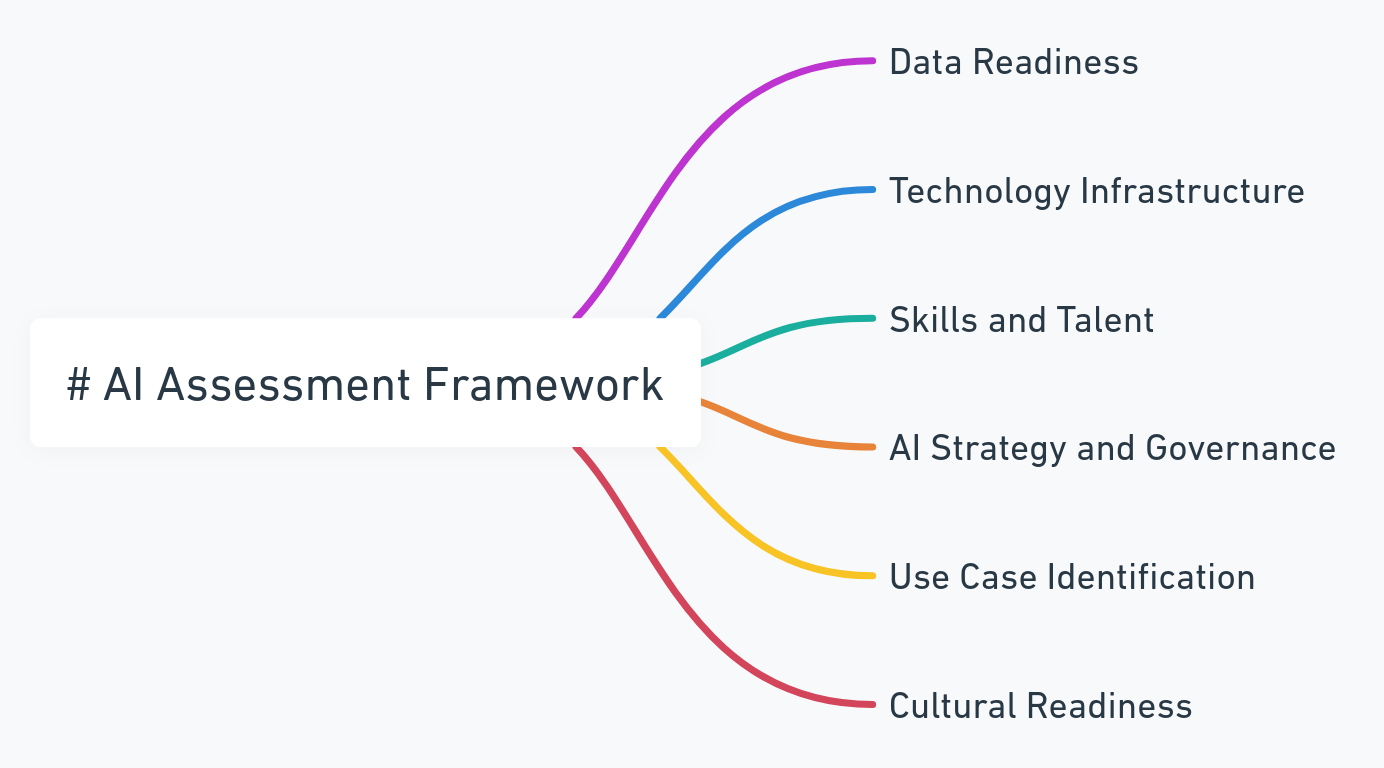
By Alen Alosious
26th Sept, 2024
As we navigate the rapidly evolving landscape of AI in 2024, businesses across industries are recognizing the transformative potential of AI technologies. However, the journey to becoming an AI-driven enterprise is not without its challenges. A critical first step in this transformation is conducting a thorough AI assessment. This process helps organizations understand their current AI capabilities, identify areas for improvement, and develop a strategic roadmap for AI adoption and implementation.
We’ll explore the key components of an AI assessment, best practices for conducting one, and how it can drive value for your organization. We’ll also examine real-world examples and industry trends to provide a practical context for your AI journey.
The Importance of AI Assessment in 2024
Before diving into the specifics of AI assessment, it’s crucial to understand why it’s more important than ever in 2024. According to a recent study by PwC, AI could contribute up to $15.7 trillion to the global economy by 2030. This staggering figure underscores the immense potential of AI to drive business growth and innovation.
However, the path to realizing these benefits is not straightforward. A 2023 survey by Gartner revealed that only 54% of AI projects make it from pilot to production. This gap between potential and realization highlights the need for a structured approach to AI adoption, starting with a comprehensive assessment.
An AI assessment serves several critical purposes
- Baseline Evaluation: It provides a clear picture of your organization’s current AI capabilities, infrastructure, and readiness.
- Gap Analysis: It identifies areas where your organization falls short in terms of AI maturity and pinpoints opportunities for improvement.
- Risk Mitigation: It helps uncover potential risks and challenges associated with AI adoption, allowing for proactive management.
- Strategic Alignment: It ensures that AI initiatives are aligned with broader business goals and objectives.
- Resource Optimization: It guides the allocation of resources (financial, human, and technological) for maximum impact.
- Competitive Positioning: It helps organizations understand how they stack up against competitors in terms of AI capabilities.
Key Components of an AI Assessment
A comprehensive AI assessment typically covers several key areas

1. Data Readiness
At the heart of any AI initiative is data. An AI assessment must evaluate the organization’s data landscape, including;
- Data Quality: Assess the accuracy, completeness, and consistency of your data.
- Data Accessibility: Evaluate how easily data can be accessed and used across the organization.
- Data Governance: Review policies and procedures for managing data throughout its lifecycle.
- Data Infrastructure: Examine the systems and technologies used for data storage, processing, and analysis.
According to a report by Accenture, organizations that invest in data quality and governance are 2.5 times more likely to successfully scale AI initiatives.
2. Technology Infrastructure
AI requires robust technological foundations. The assessment should examine;
- Computing Power: Evaluate the availability of high-performance computing resources necessary for AI workloads.
- Cloud Capabilities: Assess the organization’s cloud infrastructure and its readiness to support AI applications.
- AI Tools and Platforms: Review existing AI tools, frameworks, and platforms in use or under consideration.
- Integration Capabilities: Examine how well AI systems can integrate with existing enterprise applications.
A 2024 survey by IDC found that 68% of organizations cite inadequate IT infrastructure as a significant barrier to AI adoption.
3. Skills and Talent
The human element is crucial in AI success. The assessment should evaluate;
- AI Expertise: Assess the current level of AI knowledge and skills within the organization.
- Talent Pipeline: Evaluate strategies for attracting and retaining AI talent.
- Training and Development: Review programs for upskilling existing employees in AI-related areas.
- Collaboration: Examine cross-functional collaboration capabilities for AI projects.
According to a report by the World Economic Forum, 85% of companies expect to expand their use of AI by 2025, creating a significant demand for AI skills.
4. AI Strategy and Governance
A clear strategy and robust governance are essential for successful AI adoption. The assessment should review;
- AI Vision and Objectives: Evaluate the clarity and alignment of AI goals with overall business strategy.
- AI Ethics and Responsible AI: Assess frameworks for ensuring ethical AI development and deployment.
- AI Governance Structure: Review decision-making processes and accountability for AI initiatives.
- Risk Management: Evaluate approaches to identifying and mitigating AI-related risks.
A 2024 study by MIT Sloan Management Review found that organizations with a clear AI strategy are 5 times more likely to realize significant financial benefits from AI.
5. Use Case Identification and Prioritization
Understanding where AI can deliver the most value is crucial. The assessment should;
- Identify Potential Use Cases: Catalog areas where AI could drive significant business impact.
- Prioritization Framework: Evaluate methods for selecting and prioritizing AI initiatives.
- ROI Analysis: Assess capabilities for measuring and projecting the return on AI investments.
- Pilot Programs: Review approaches to testing and validating AI use cases.
According to McKinsey’s “State of AI” report, organizations that systematically identify an
6. Cultural Readiness
Organizational culture plays a significant role in AI adoption. The assessment should examine;
- AI Awareness: Evaluate the general understanding and perception of AI across the organization.
- Change Management: Assess capabilities for managing the organizational changes required for AI adoption.
- Innovation Culture: Review the organization’s appetite for experimentation and risk-taking.
- Leadership Support: Evaluate executive buy-in and support for AI initiatives.
A 2024 survey by Deloitte found that 67% of organizations cite cultural barriers as a significant challenge in AI adoption.
Conducting an AI Assessment – Best Practices
Let’s explore best practices for conducting an effective AI assessment
1. Engage Stakeholders Across the Organization
AI impacts various aspects of a business, making it crucial to involve stakeholders from different departments. This includes;
- C-Suite Executives: To ensure alignment with overall business strategy.
- IT Leadership: To assess technical readiness and infrastructure needs.
- Data Science Teams: To evaluate current AI capabilities and potential.
- Business Unit Leaders: To identify potential use cases and business impact.
- Legal and Compliance Teams: To address regulatory and ethical considerations.
2. Use a Structured Framework
Adopt a structured approach to ensure comprehensive coverage. Many organizations use frameworks like the AI Maturity Model or the AI Readiness Assessment Framework. These provide a systematic way to evaluate different aspects of AI readiness and maturity.

3. Leverage External Expertise
Consider partnering with AI consultants or advisory firms like Teqfocus to bring an outside perspective and industry benchmarks. Their experience can provide valuable insights and help identify blind spots in your assessment.
4. Conduct a Thorough Data Audit
Given the critical role of data in AI, a detailed data audit is essential. This should cover;
- Data Inventory: Catalog all data sources and types.
- Data Quality Assessment: Evaluate data accuracy, completeness, and consistency.
- Data Privacy and Security: Review compliance with data protection regulations.
- Data Integration Capabilities: Assess how easily data can be combined from different sources.
5. Assess AI Capabilities Against Industry Benchmarks
Compare your organization’s AI capabilities to industry standards and competitors. This can help identify areas where you’re lagging behind or leading the pack.
6. Evaluate AI Ethics and Responsible AI Practices
As AI becomes more prevalent, ensuring ethical and responsible AI practices is crucial. Assess your organization’s approach to;
- Bias Detection and Mitigation: Evaluate methods for identifying and addressing bias in AI systems.
- Transparency and Explainability: Assess capabilities for making AI decision-making processes transparent.
- Privacy Protection: Review measures for safeguarding personal data in AI applications.
- Accountability Frameworks: Evaluate structures for ensuring accountability in AI development and deployment.
7. Conduct Pilot Projects
As part of the assessment, consider running small-scale AI pilots. These can provide practical insights into your organization’s readiness and help identify potential challenges.
8. Develop a Comprehensive Report and Action Plan
The output of your AI assessment should be a detailed report that includes;
- Current State Analysis: A clear picture of your organization’s AI capabilities and maturity.
- Gap Analysis: Identification of areas needing improvement.
- Prioritized Recommendations: A roadmap for addressing gaps and advancing AI initiatives.
- Resource Requirements: Estimates of the financial, human, and technological resources needed.
- Risk Assessment: Identification of potential risks and mitigation strategies.
- Timeline: A proposed timeline for implementing recommendations.
Real-World Examples of AI Assessment in Action
To illustrate the impact of AI assessment, let’s look at some real-world examples;
- Financial Services: A leading U.S. bank conducted an AI assessment that revealed significant gaps in its data infrastructure. By addressing these gaps, the bank was able to implement an AI-driven fraud detection system that reduced fraudulent transactions by 60% within the first year.
- Healthcare: A large healthcare provider’s AI assessment identified opportunities for AI in patient care. This led to the implementation of an AI-powered diagnostic tool that improved early disease detection rates by 35% and reduced diagnostic errors by 25%.
Conclusion
In 2024, conducting a comprehensive AI assessment is no longer optional for organizations aiming to stay competitive in the AI-driven business landscape. It’s a crucial first step in the journey to becoming an AI-powered enterprise, providing the insights and direction needed to navigate this complex and rapidly evolving field.
As you embark on your AI assessment journey, keep in mind that this is an ongoing process. The AI landscape is constantly evolving, and regular reassessments will be necessary to stay ahead of the curve. With a thorough and strategic approach to AI assessment, your organization can unlock new opportunities, drive innovation, and achieve sustainable competitive advantage in the AI era.
